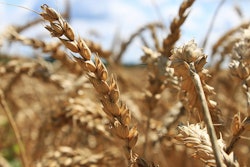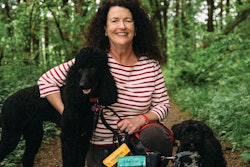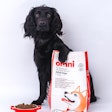
Canidae Pet Food aspires to have a hand in the farming and ranching of every ingredient in their dog and cat foods, Rafi Kalachian, director of marketing at Canidae, told Petfood Industy. The company recently took the first step on that thousand-mile journey by founding Canidae Farms in Cheney, Kansas, USA.
“Pet owners not only want high quality products, they want to know how those ingredients were produced,” Kalachian said.
While many natural pet foods use sustainable and local ingredients, Canidae is the first to own a farm specifically to grow some of their ingredients, according to Kalachian. Eventually on Canidae Farms, sustainable agriculture could provide meat, grains, vegetables and fruit, while safeguarding the environment.
Know your farmer, know your pet food
Bison from Wyoming, lamb from Colorado and salmon from the US Northwest have all been in Canidae’s pet foods for years, Kalachian said. Canidae sought a way to go beyond current trends, while gaining greater control over their pet food ingredients.
"What if we actually grew our own ingredients?” he said. ”How do we take it to the next level, where you have complete responsibility, traceability, accountability of what's going into the food?”
The US Department of Agriculture adopted the phrase “know your farmer, know your food” to exemplify the connections among the land, farmers and human nutrition. Kalachian literally knew the farmer when Canidae decided to vertically integrate agriculture into their dog and cat food company.
Around three years ago, Kalachian contacted his friend Clint Brauer, a third-generation Kansas farmer. Brauer grew up farming, but built a career working on software. A desire to create something more enduring and significant than a website drove Brauer to return to his roots in the soil, he told Petfood Industry.
Brauer believes innovative agriculture can be both economically productive and ecologically balanced. While not strictly organic, he seeks to eliminate synthetic fertilizers and herbicides on Canidae Farms.
"The idea is to go back to more natural methods, but use technology to get there,” he said.
So far, he has grown milo (sorghum), millet, peas, zuchini, butternut squash, pumpkins, parsley, sage, rosemary and tomatoes for use as Canidae’s pet food ingredients.
Pet food sustainability and farming
For Brauer, the connection between pet health and agriculture became clear in one incident.
"I almost lost my dog a few years ago after an algae bloom in a lake," he said. Run-off of synthetic fertilizers from croplands may fuel aquatic algae population booms that can harm people and animals. "If you connect those dots, it doesn't make lots of sense. We're destroying things for ourselves.”
To avoid agrarian self-destruction, Brauer uses a system known as integrated farming. He intends to reduce, or even reverse, the negative effects of agriculture on the soil, water and air. Ultimately, he aims to make Canidae Farms a nearly closed loop in which crops, livestock, machines and humans produce the resources each other needs.
"The idea is to make the farm a self-contained unit," he said.
Agricultural ecosystem of Canidae Farms
Integrated farming can protect the environment and allow Canidae Pet Foods to make unique sustainability claims. Meanwhile, the same techniques also guard Brauer’s crops in a land once ravaged by the Dust Bowl, a series of 1930s droughts exacerbated by human activity.
"Regardless of what you think of climate change, where we farm in Kansas, you can have extreme weather," Brauer said.
Many of Clint's farming techniques build the soil ecosystem to improve the productivity and resilience of the land over time. On Canidae Farms, sheep nibble weeds and post-harvest crop leftovers in fields. Along with that pastoral salad, the sheep eat feed made from the farm’s crop leftovers that return from a nearby seed-cleaning mill.
When nature calls, the sheep leave their natural, pelletized, slow-release fecal fertilizer. Cover crops help restore soil nitrogen and reduce weeds, while protecting against erosion. By not tilling the fields, he maintains the soil structure. This protects the beneficial organisms in the soil that aid crop roots, while resisting erosion better than a furrowed field.
Stewarding the soil buffers crops against both droughts and deluges. Healthy soil can absorb rain better and hold it longer than damaged dirt.
"You're bringing the soil back alive," said Brauer. "Which over the long-term, reduces the odds of a failed crop. Using the methods we're using, you can store up to five times the amount of water in the soil, versus run-off."
Dependable harvests reduce a farmers' exposure to fluctuations in market prices, he said. For Canidae, that also means a steady supply of natural ingredients grown exactly how they want them.
Next steps for Canidae Farms
Of those ingredients, Canidae Farms currently harvests only grains and produce, but the farm’s weed-eater sheep could serve another purpose as a common dog food ingredient, lamb.
"One of the things that we were recently talking about is how do we expand on the sheep," said Kalachian. "If we can increase the number of sheep to a few thousand, then there's your lamb. That's where the protein comes in."
The sheep could be raised using animal welfare standards, he said, which would give Canidae another feather in its cap.
University of Göttingen, Germany scientists found evidence that seeing pet food label claims about animal welfare issues, such as free-range, may incline pet owners to purchase those products.
Challenges of farming pet food ingredients
Humanely raised lambs may help Canidae Farms take a few more steps along their thousand-mile journey, said Kalachian, but that waypoint is still in the distance. The strategy has been to take it slow, and let Brauer’s agronomy expertise lead, as opposed to the ephemeral demands of pet food trends.
Canidae has been patient, Brauer said. Communications was key, along with back and forth transparency about consumer demands and farming reality.
"That's been a conversation we've had since the beginning," Brauer said, “They’d ask, ’Can we do it this way?' and I’d say, 'Well, it's a little more complicated than that.’"
That conversation seems likely to be repeated as Canidae Farms continues to pioneer in both sustainable agricultural and pet food ingredient sourcing.



















